unit 7 biology
1/95
Earn XP
Description and Tags
12th grade ap biology
Name | Mastery | Learn | Test | Matching | Spaced |
|---|
No study sessions yet.
96 Terms
charles darwin
- english naturalist
- researched at galapagos islands
- interested in biogeography (geographic distribution of species)
- hypothesis: organisms left south america and colonized the galapagos islands where they then diversified and gave rise to new species
descent with modification/evolution
- change in the genetic makeup of a population over time
- population evolve, not individuals
heritable traits
change from generation to generation
natural selection
- a process in which individuals that have certain traits tend to survive and reproduce at higher rates than other individuals because of those traits
- acts on phenotypic variations in populations. some phenotypes will increase or decrease an organism's fitness
- nature "selects" traits that are better suited for survival and reproduction
fitness
- ability to survive and reproduce
- measured by reproductive success
selective pressures
happens to populations when environments change
theory of natural selection
- based on darwin's observations
1. traits are heritable
2. more offspring are produced than can survive
traits are heritable
- characteristics can be passed from parent to offspring
- adaptations
adaptations
inherited characteristics of organisms that enhance their survival and reproduction
more offsprings produced than can survive
- leads to competition for limited resources, resulting in differential survival
- traits that lead to survival (favorable traits) will accumulate in the population
artificial selection
- the selective breeding of domesticated plants and animals to encourage the occurrence of desirable traits
- humans select traits that are desirable
population
- a group of individuals of the same species that live in the same area and interbred to produce fertile offspring
- allele frequency will change over time
gene pool
- a population's genetic makeup
- consists of all copies of every type of allele
- if there is only one allele present for a particular locus in the population, it is fixed
fixed alleles
leads to less genetic diversity
microevolution
- small scale genetic changes in a population/change in allele frequencies within a single species or population
- driver by random occurrences: mutations, genetic drift, migration/gene flow, natural selection
mutations
- can result in genetic variation
- can form new alleles
- natural selection can act on varied phenotypes
- rates tend to be slow in plants and animals; fast in prokaryotes due to a faster generation time
- most all in neutral to harmful range
- not all lead to evolution
genetic drift
- chance events that cause a change in allele frequency from one generation to the next
- most significant to small populations
- can lead to a loss of genetic variation
- can cause harmful alleles to become fixed
- does not produce adaptation
- types: bottleneck and founder effect
bottleneck effect
- when a large population is drastically reduced by a non-selective disaster
- some alleles may become overrepresented, underrepresented, or absent
- ex: natural disasters, hunting, habitat loss
founder effect
- when a few individuals become isolated from a large population and establish a new small population with a gene pool that differs from the large population
- lose genetic diversity
- ex: amish ppl
gene flow
- the transfer of alleles into or out of a population due to fertile individuals or gametes
- alleles can be transferred between populations
- ex: pollen being blown
reproductive success
measured by relative fitness
relative fitness
the number of surviving offspring that an individual produces compared to the number left by others in the population
measuring effects of natural selection
- measured by examining the changes in the mean of phenotypes
1. directional selection
2. stabilizing selection
3. disruptive selection
directional selection
- selection towards one extreme phenotype
- ex: black or white shells

stabilizing selection
- selection towards the mean and against the extreme phenotypes
- ex: gray shells
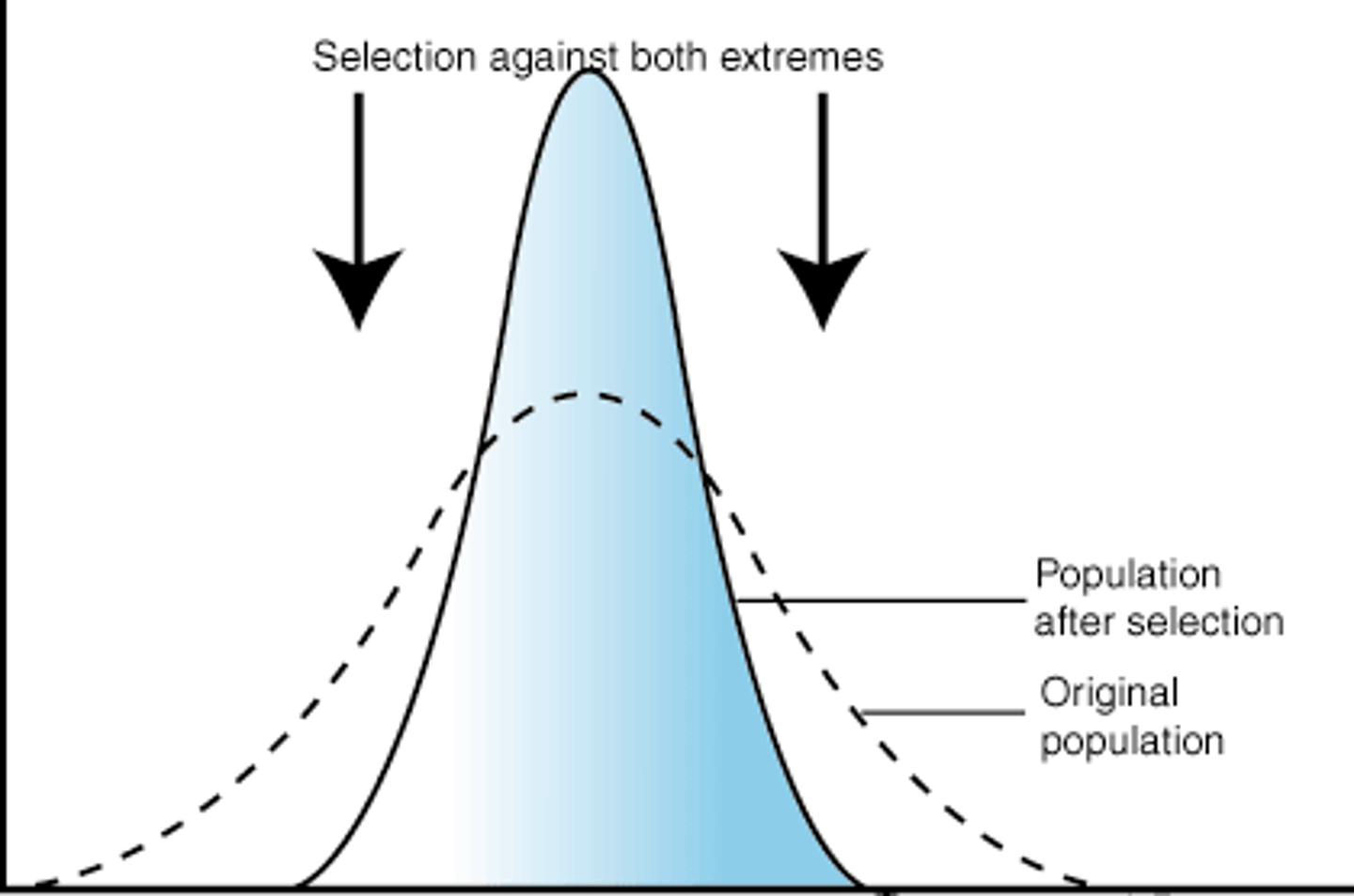
disruptive selection
- selection against the mean, both phenotypic extremes have the highest relative fitness
- ex: against gray shells, favor black and white shells
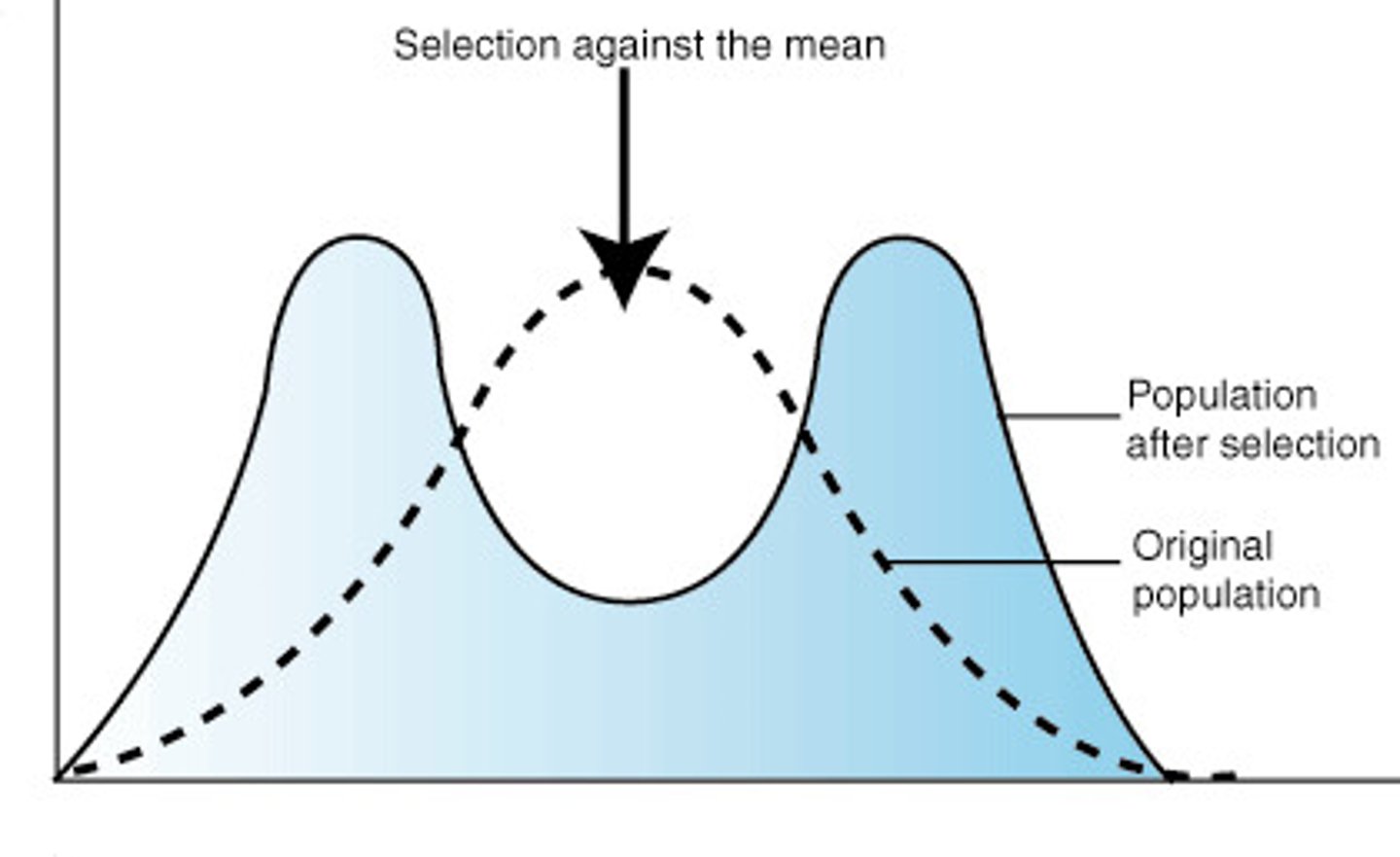
sexual selection
- a type of natural selection that explains why many species have unique/showy traits
- can produce traits that are harmful to survival
- ex: peacock feathers
evolution evidence
- fossil record
- comparative morphology
- biogeography
fossils
- remains or traces of past organisms
- can be dated by examining the rate of carbon 14 decay and the age of rocks where it was found
fossil record
- gives a visual of evolutionary change over time
- gives geographical data for the organisms found
comparative morphology
- analysis of the structures of living and extinct organisms
- includes homology, vestigial structures, convergent evolution, analogous structures
homology
characteristics in related species that have similarities even if the functions differ
embryonic homology
many species have similar embryonic development
vestigial structures
- structures that are conserved even though they no longer have a use
- ex: appendix, wisdom teeth
molecular homology
many species share similar DNA and amino acid sequences
homologous structures
- characteristics that are similar in two species because they share a common ancestor even though functions differently
- ex: arm bone
convergent evolution
- similar adaptations that have evolved in distantly related organisms due to similar environments
- ex: analogous traits
analogous structures
- structures that are similar but have separate evolutionary origins
- ex: wings in birds, bats, and bees
structural evidence
- indicates common ancestry of all eukaryotes
- cellular examples: membrane-bound organelles, linear chromosomes, introns in genes
biogeography
- the distribution of animals and plants geographically
- ex: species on oceanic islands resemble mainland species
- ex: species on same continent are similar and distinct from species on other continents
hardy weinberg equilibrium
- used to assess whether natural selection or other factors are causing evolution at a particular locus
- determines what the genetic makeup of the population would be if it were not evolving
- no differences -> population not evolving
- differences -> population may be evolving
hardy weinberg principle
frequencies of alleles and genotypes in a population will remain constant from generation to generation, provided that only mendelian segregation and recombination of alleles are at work
hardy weinberg conditions
- no mutations
- random mating
- no natural selection
- extremely large population size
- no gene flow
- if any are met, then microevolution occurs
alleles
p + q = 1
genotypes
p² + 2pq + q² = 1
dominant allele
p
recessive allele
q
homozygous dominant
p²
heterozygous
2pq
homozygous recessive
q²
systematics
classification of organisms and determining their evolutionary relationships
taxonomy
naming and classifying species
phylogenetics
- hypothesis of evolutionary history
- use phylogenetic trees to show evolution
how scientists determine evolutionary relationships
- fossil records
- DNA (most exact)
- proteins
- homologous structures
phylogenetic trees
- diagrams that represent the evolutionary history of a group of organisms
- shows the amount of change over time measured by fossils
cladograms
similar to phylogenetic trees
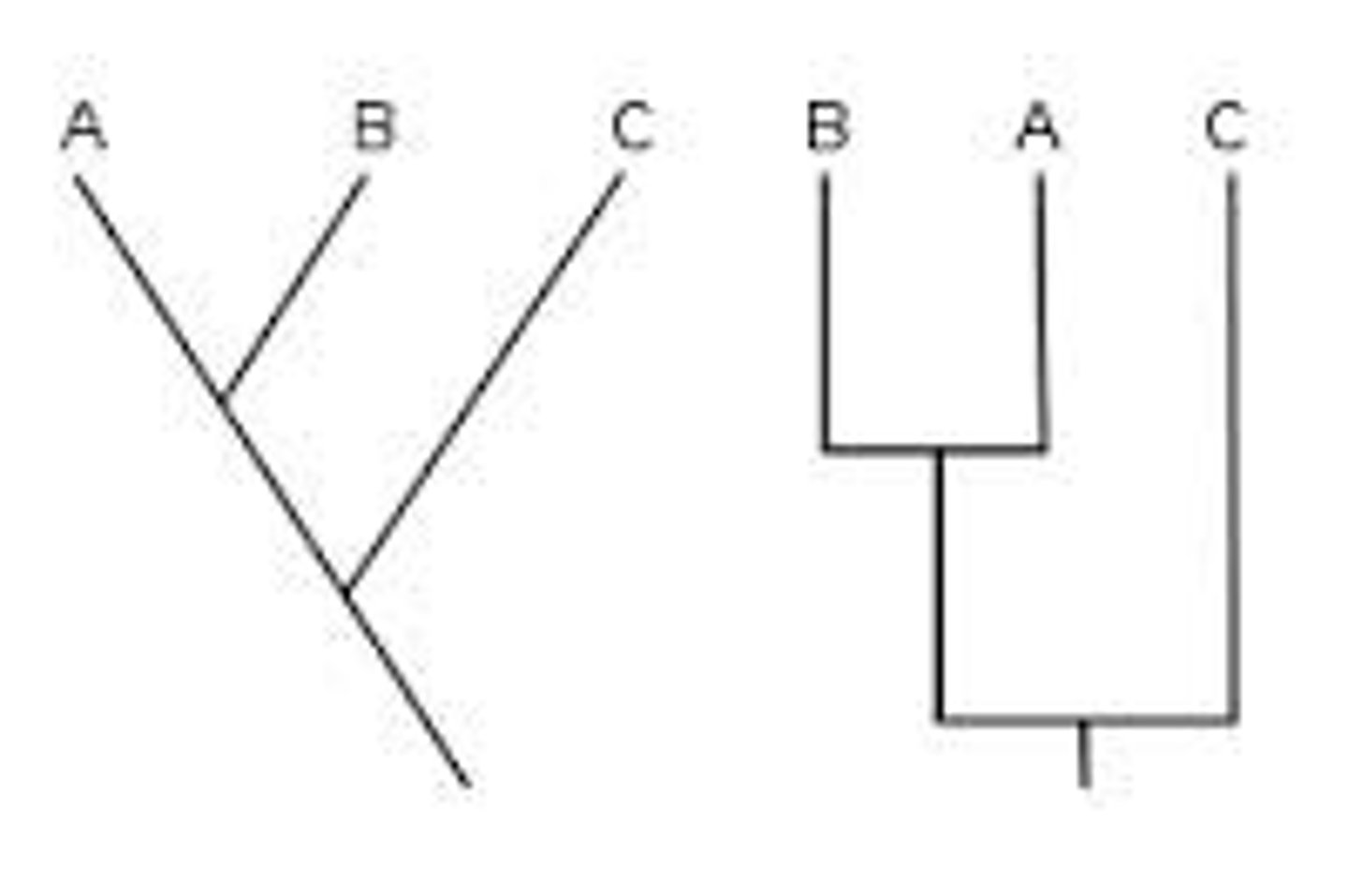
lineage
each line on a cladogram
node
- each branching point on a cladogram
- represent common ancestor
clades
- nodes and all branches from it
- species have shared derived features
root
common ancestor of all the species
sister taxa
- two clades that emerge from the same node
- can swap places
basal taxon
- a lineage that evolved from the root and remains unbranched
- out group: least related to the rest
synapomorphy
a derived character shared by clade members
derived characteristics
similarity inherited from the most recent common ancestor of an entire group
ancestral characteristic
similarity that arose prior to the common ancestor
monophyletic group
includes the most recent common ancestor of the group and all of its descendants (clade)
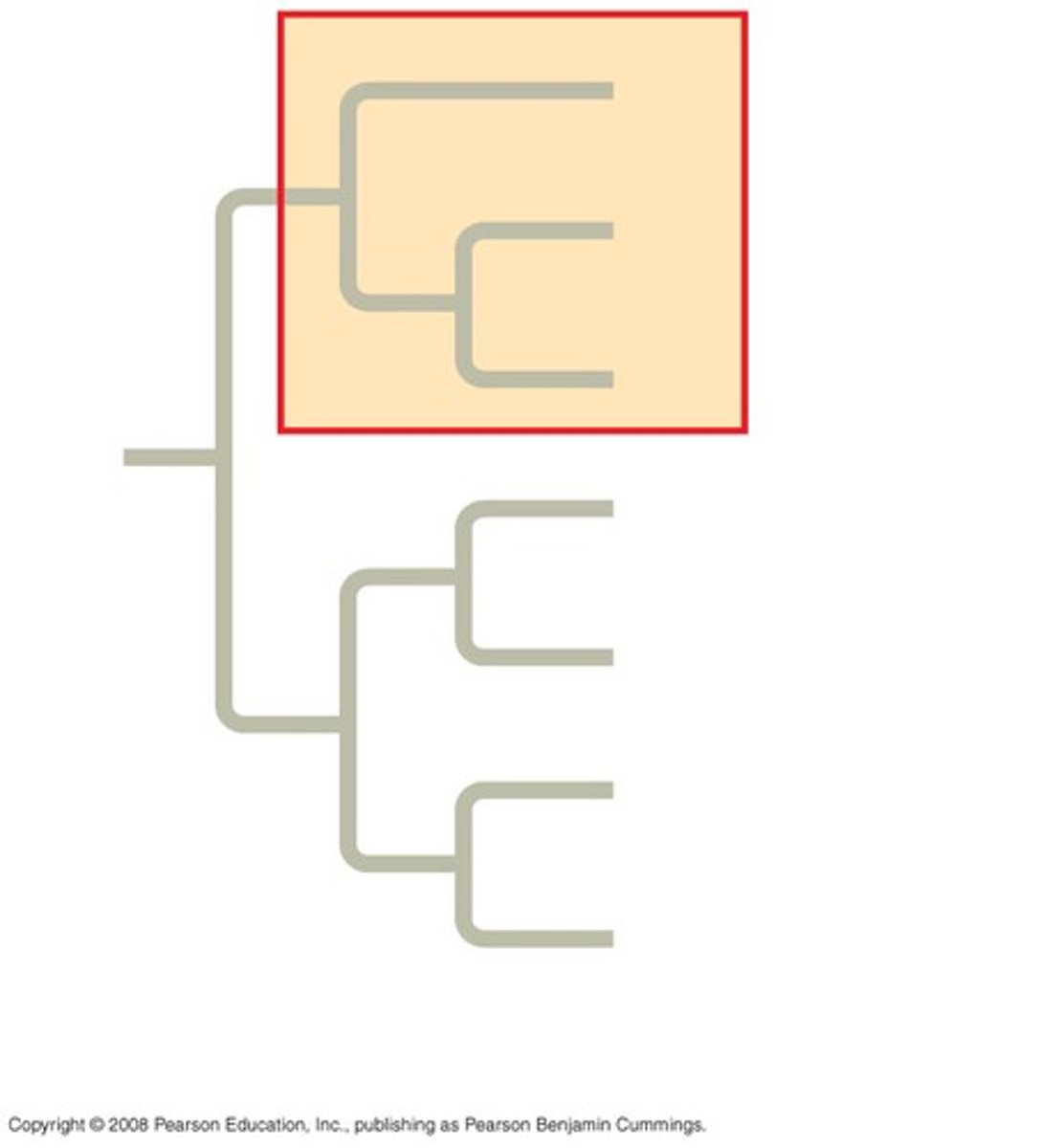
paraphyletic group
includes the most recent common ancestor of the group but not all its descendants
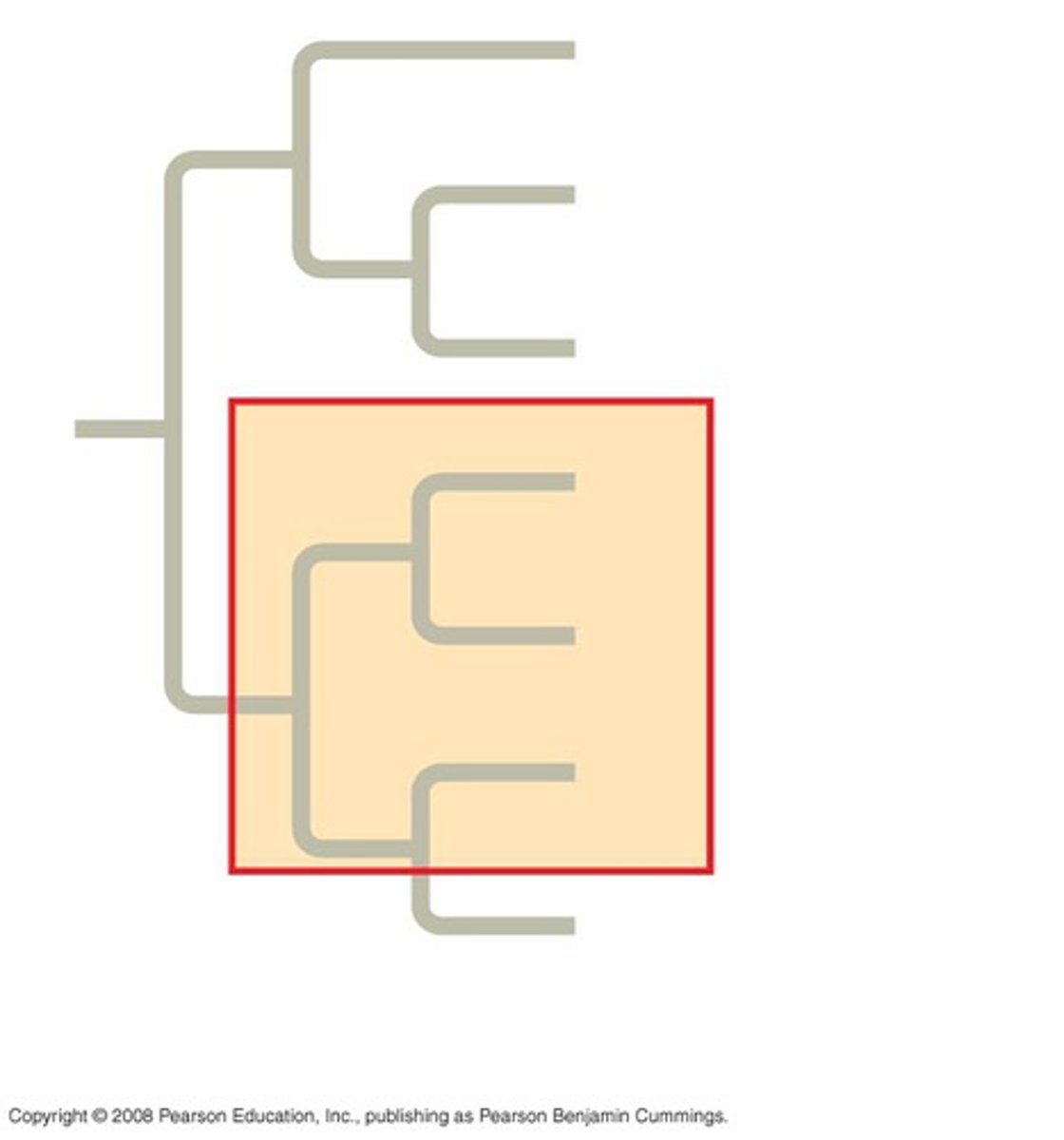
polyphyletic group
does not include the most recent common ancestor of all members of the group
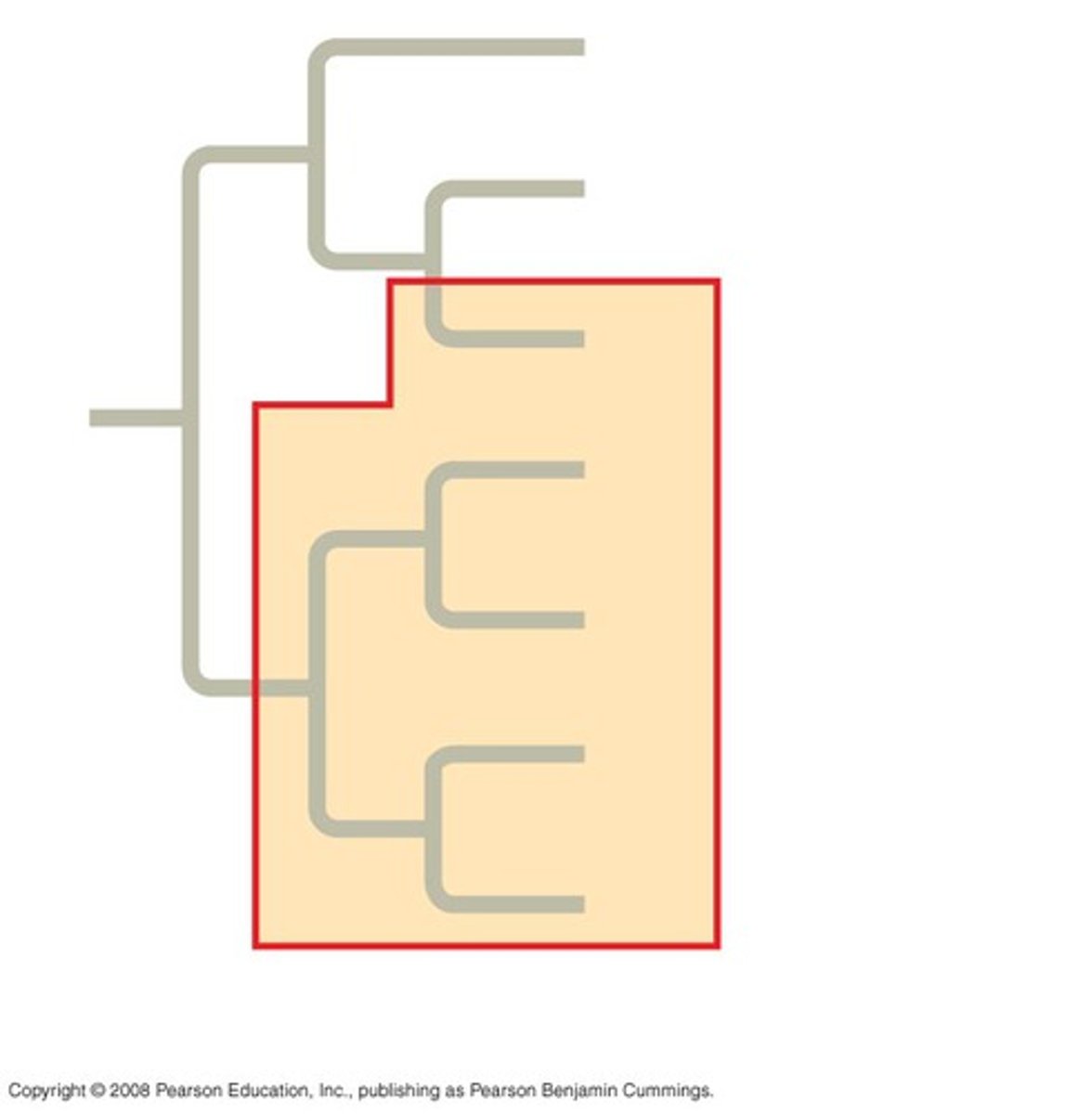
parsimony
if there are conflicts among characters, use the hypothesis that requires the fewest assumptions (DNA changes)
species
a group able to interbreed and produce viable, fertile offspring
speciation
- formation of new species
- results in diversity of life forms
- occurs due to reproductive isolation
allopatric speciation
- physical barrier divides population or a small population is separated from main population
- populations are geographically isolated: prevents gene flow, often caused by natural disasters
sympatric speciation
- a new species evolves while still inhabiting the same geographic region as the ancestral species
- usually due to the exploitation of a new niche
reproductive isolation
prezygotic barriers and postzygotic barriers maintain isolation and prevent gene flow between the populations
prezygotic barriers
- before fertilization
- prevent mating or hinder fertilization
- types: habitat isolation, temporal isolation, behavioral isolation, mechanical isolation, gametic isolation
habitat isolation
species live in different areas or they occupy different habitats within the same area
temporal isolations
species breed at different times of the day, year, or season
behavioral isolation
unique behavioral patterns and rituals separate species
mechanical isolation
the reproductive anatomy of one species does not fit with the anatomy of another species
gametic isolation
proteins on the surface of gametes do not allow for the egg and sperm to fuse
postzygotic barriers
- after fertilization
- prevent a hybrid zygote from developing into a viable, fertile adult
- types: reduced hybrid viability, reduced hybrid fertility, hybrid breakdown
reduced hybrid viability
- the genes of different parent species may interact in ways that impair the hybrid's development or survival
- ex: domestic sheep can fertilize domestic goats, but the hybrid embryo dies early on
reduced hybrid fertility
- a hybrid can develop into a healthy adult, but it is sterile
- usually results due to differences in number of chromosomes between parents
- ex: male donkey and female horse can mate to produce a mule, but mules are sterile
hybrid breakdown
- the hybrid of the first generation may be fertile but when they mate with a parent species or one another, their offspring will be sterile
- ex: farmers crossing different types of cotton plants but after the first generation the plants do not produce viable seeds
macroevolution
large evolutionary patterns (adaptive radiation, mass extinction)
stasis
no change over long periods of time
punctuated equilibrium
when evolution occurs rapidly after a long period of stasis
gradualism
when evolution occurs slowly over hundreds, thousands, or millions of years
divergent evolution
- groups with the same common ancestor evolve and accumulate differences resulting in the formation of a new species
- caused by adaptive radiation
adaptive radiation
if a new habitat or niche becomes available, species can diversify rapidly
extinction
- the termination of a species
- 5 mass extinctions in history
- human activity has affected rates
- quickens during ecological stress
- extinction of a species opens up a niche that can be exploited by a different species
origins of life
- earth formed approximately 4.6 billion years ago
- early earth was not suitable for life until 3.9 billion years ago
- earliest fossil evidence is 3.5 billion years ago (cyanobacteria)
how organic molecules formed
- inorganic molecules could have synthesized them due to free energy and abundant oxygen
- could have been transported to earth via meteorites or other celestial events
stanley miller and harold urey
- found organic compounds and amino acids formed from lightning
- hypothesized that the organic molecules that formed served as the building blocks for macromolecules
RNA world hypothesis
- proposes that RNA could have been the earliest genetic material
- helps to explain the pre-cellular stage of life
endosymbiont theory
- chloroplast and mitochondria evolved from prokaryotes
- evolutionary evidence: circular DNA, ribosomes, double membrane